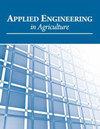估算隔热需求的室外空气和室内空气设计温度的比较
IF 0.8
4区 农林科学
Q4 AGRICULTURAL ENGINEERING
引用次数: 0
摘要
设计的空气温度不考虑环境天气的影响,如对流加热/冷却和太阳辐射。设计空气温度可能无法准确估计在温暖条件下肉鸡舍的传热情况。使用太阳-空气温度作为设计参数可以优化传热的估计。太阳-空气温度可以用历史气象数据预测,并用作设计参数。本研究支持以太阳-空气温度作为设计参数的适宜性。摘要热应激对家禽生产效率、健康和福利产生不利影响。鸡舍的隔热要求通常是根据工程设计空气温度来规定的,忽略了环境天气的影响,如对流加热和冷却,以及太阳辐射。本研究的目的是:(1)监测商品肉鸡鸡舍的外部温度,以验证将土壤-空气温度作为肉鸡鸡舍设计参数的适用性;(2)利用历史气象数据,利用太阳-空气温度模拟不同气候地点模拟肉鸡舍在温暖天气下太阳辐射对传导热增益的影响。在两个7天的温暖季节(9月和5月),记录了阿拉巴马州北部一个肉鸡鸡舍朝东侧壁的环境空气、外表面温度和太阳辐射,并用于计算太阳-空气温度。在这两个时期,最大日地表(Tsurface)和土壤-空气(Tsol-air)温度显著升高(P <0.0001),与最高环境空气温度(Tair)相比。9月(P = 0.2144)和5月(P = 0.1544)最大地表和Tsol-air差异不显著。此外,利用历史气象数据,利用Tair和Tsol-air对位于美国10个不同肉鸡地区的模型结构在白天温暖条件下的导热传热(增益/损失)进行了模拟。对于每个模拟,与使用Tair计算的导热传热相比,使用Tsol-air计算的导热传热要高得多。目前用于指定肉鸡鸡舍设计和建造的设计温度的方法可能导致隔热不足,而Tsol-air提供了白天条件下导热传热的改进估计。关键词:肉鸡舍,设计温度,传热,隔热,家禽,太阳辐射,太阳-空气温度,热包络本文章由计算机程序翻译,如有差异,请以英文原文为准。
Comparison of Outside Air and Sol-Air Design Temperatures for Estimating Insulation Needs
Highlights Design air temperatures disregard ambient weather effects such as convective heating/cooling and solar radiation. Design air temperatures may not yield accurate estimates of heat transfer for broiler houses during warm conditions. The use of sol-air temperature as a design parameter could serve to optimize estimates of heat transfer. Sol-air temperatures can be predicted with historical meteorological data and used as a design parameter. This study supports the appropriateness of using sol-air temperature as a design parameter. Abstract. Thermal stress adversely affects poultry production efficiency, health, and welfare. Poultry house insulation requirements are typically specified based on engineering design air temperatures, which disregards ambient weather effects such as convective heating and cooling, and solar radiation. The objectives of this study were: (1) to monitor external temperatures of a commercial broiler house to verify the suitability of using sol-air temperature as a design parameter for broiler housing design; (2) to use the sol-air temperature to simulate the effects of solar radiation on conductive heat gain during warm weather for a modeled broiler house in varying climatic locations using historical meteorological data. For two 7-day warm season periods (September and May), ambient air, exterior surface temperatures, and solar radiation were recorded for an east facing sidewall of a broiler house in northern Alabama and used to calculate sol-air temperatures. For both periods, maximum daily surface (Tsurface) and sol-air (Tsol-air) temperatures were significantly elevated (P < 0.0001) as compared to maximum ambient air temperatures (Tair). Maximum Tsurface and Tsol-air were not significantly different for September (P = 0.2144) and May (P = 0.1544), respectively. Additionally, simulations of conductive heat transfer (gain/loss) using Tair and Tsol-air were performed for a model structure located in ten different broiler regions in the United States during daytime warm conditions using historical meteorological data. For each simulation, conductive heat transfer calculated using Tsol-air was considerably higher when compared to conductive heat transfer calculated using Tair. Methods currently used to specify design temperatures for broiler house design and construction can result in inadequate thermal insulation and Tsol-air provides improved estimates of conductive heat transfer during daytime conditions. Keywords: Broiler house, Design temperature, Heat transfer, Insulation, Poultry, Solar radiation, Sol-air temperature, Thermal envelope.
求助全文
通过发布文献求助,成功后即可免费获取论文全文。
去求助
来源期刊

Applied Engineering in Agriculture
农林科学-农业工程
CiteScore
1.80
自引率
11.10%
发文量
69
审稿时长
6 months
期刊介绍:
This peer-reviewed journal publishes applications of engineering and technology research that address agricultural, food, and biological systems problems. Submissions must include results of practical experiences, tests, or trials presented in a manner and style that will allow easy adaptation by others; results of reviews or studies of installations or applications with substantially new or significant information not readily available in other refereed publications; or a description of successful methods of techniques of education, outreach, or technology transfer.
 求助内容:
求助内容: 应助结果提醒方式:
应助结果提醒方式:


